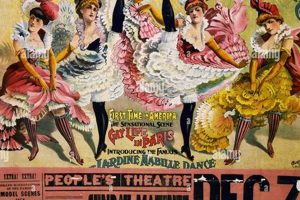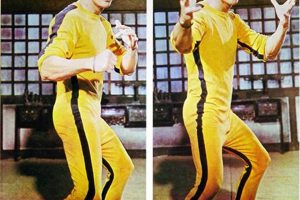The term refers to original promotional or commemorative graphics produced for or associated with the rock band the Grateful Dead, created during their active years (1965-1995) or shortly thereafter. These artifacts often advertise specific concerts, tours, or album releases and are typically screen-printed or lithographed on paper stock. A specific illustration promoting a 1966 show at the Avalon Ballroom would exemplify the category.
These items hold significant cultural and historical value. They are tangible pieces of music history, representing a specific era and counter-cultural movement. Their rarity, condition, and artistic merit dictate their collectibility and subsequent monetary worth. Understanding the context of their creation provides insight into the band’s evolution and the broader cultural landscape they influenced. Appreciation extends beyond simple fandom, touching upon art history, graphic design, and social commentary.
Further discussion will explore the artists who created these images, the factors influencing their value, and the resources available for identification and authentication.
Considerations for Acquiring Authentic Grateful Dead Era Graphics
Potential buyers and collectors should exercise caution and diligence when evaluating items represented as period Grateful Dead promotional material. Verification and informed purchasing practices are crucial in this market.
Tip 1: Authenticate the Printer. Research known printers such as West Coast Lithograph Company or Tea Lautrec Litho, and cross-reference their styles with the specific poster being considered. Identifying the original printer provides a preliminary validation check.
Tip 2: Examine Paper Stock and Printing Techniques. Original items often utilized specific paper types and printing methods (e.g., screen printing, lithography). Analyze the paper’s texture, weight, and the ink application method to ensure they align with established historical practices.
Tip 3: Scrutinize the Artwork Details. Compare the artwork’s resolution, color saturation, and line quality against known authentic examples. Discrepancies in these elements may indicate a reproduction.
Tip 4: Investigate Provenance. Seek documentation or verifiable history regarding the item’s ownership and origin. A clear chain of custody strengthens the legitimacy of a item.
Tip 5: Consult with Experts. Engage reputable appraisers or specialists knowledgeable in the field of vintage concert posters. Their expertise can provide informed assessments and validation.
Tip 6: Beware of Common Reproduction Indicators. Be wary of posters with overly glossy finishes, pixelated images, or inconsistent color palettes, as these characteristics are often associated with reproductions.
Tip 7: Evaluate Condition Carefully. While minor imperfections can be expected in vintage items, significant damage or restoration can impact value and potentially raise questions about authenticity.
Adhering to these guidelines helps mitigate the risk of acquiring inauthentic items and ensures a more informed collecting experience.
The subsequent sections will delve into identifying specific artists and their styles, furthering the collector’s ability to discern genuine articles.
1. Artist Attribution
Artist attribution constitutes a pivotal aspect in assessing the significance and value within the realm of these relics. Identifying the artist responsible for the artwork is crucial for establishing its provenance, historical context, and potential market appeal.
- Influence on Value
The recognized stature and reputation of an artist directly impact the monetary value of a associated poster. Works by prominent psychedelic artists such as Stanley Mouse, Alton Kelley, Rick Griffin, and Wes Wilson command higher prices due to their established legacies and artistic contributions. Their unique styles and association with the counterculture movement amplify desirability among collectors.
- Authentication Aid
An artist’s signature style and distinctive artistic techniques serve as valuable tools in verifying the authenticity. Familiarity with an artist’s body of work allows for comparison and identification of potential forgeries or reproductions. Characteristics such as linework, color palettes, and compositional elements can provide critical clues.
- Historical Contextualization
Artist attribution provides context to the broader art and cultural landscape of the era. It situates posters within the timeline of the psychedelic art movement, illuminating the artists’ influences, collaborations, and contributions to the visual language of the Grateful Dead’s music and cultural milieu. Understanding the artists’ backgrounds enriches the understanding of the Grateful Dead legacy.
- Genre Distinction
Certain artists specialized in specific subtypes within the poster art world. Some focused on intricate lettering, while others excelled at character design or psychedelic imagery. Identifying an artist’s specialty further refines the classification and potentially boosts the collector’s market. For example, a poster noted for innovative typography might be more sought after if attributed to a designer known for that skill.
In summation, artist attribution serves as a linchpin in evaluating these objects. Beyond mere identification, it contributes to validating authenticity, determining value, and connecting pieces to larger cultural and artistic narratives.
2. Printing Techniques
The printing techniques employed in producing rock band concert posters, including those of the Grateful Dead, constitute a fundamental aspect of their authenticity, collectibility, and historical significance. The methods used primarily screen printing and offset lithography directly influenced the visual characteristics, durability, and production costs associated with these artifacts. Original screen prints, often characterized by vibrant colors and thick ink deposits, reflect the manual processes of the era and are generally more valued due to their limited production runs. Offset lithography, while capable of producing finer details and larger quantities, can often be distinguished by its smoother ink application and dot-matrix patterns under magnification. Identifying the printing technique provides a crucial indicator of whether a poster is an original from the period or a later reproduction.
Furthermore, variations within these primary techniques offer additional insights. For example, certain printers developed unique screen-printing methods that resulted in distinctive textures or color blends. The quality of paper stock used in conjunction with the printing technique also contributes to the poster’s overall condition and longevity. Original posters often exhibit age-related characteristics, such as paper discoloration or minor imperfections inherent to the printing process. In contrast, modern reproductions frequently utilize different paper types and printing technologies, resulting in a visually distinct product that lacks the tactile qualities and subtle nuances of the originals. An authentic first-run poster from a Family Dog show in 1966, screen printed by Tea Lautrec Litho, would possess specific ink densities and color separations absent in a digitally printed facsimile.
In conclusion, a comprehensive understanding of printing techniques represents an essential component in evaluating the value and authenticity of rock band concert posters. Distinguishing between screen printing, offset lithography, and their respective variations enables collectors and historians to differentiate genuine period pieces from reproductions. The careful examination of ink deposition, paper stock, and printing characteristics provides a critical framework for assessing the historical and artistic merit of these artifacts, while also acting as a vital safeguard against deception in the market. Subsequent examinations will address how to ascertain rarity.
3. Rarity Assessment
Rarity assessment constitutes a critical component in determining the value and desirability of vintage Grateful Dead promotional materials. The scarcity of a particular poster directly correlates with its market value, making accurate determination of rarity an essential skill for collectors and investors.
- Limited Print Runs
Many original Grateful Dead posters were produced in relatively small quantities. Factors such as budgetary constraints, the venue’s size, and the band’s popularity at the time contributed to these limited print runs. A poster advertising an early show at the Avalon Ballroom, with an estimated print run of only a few hundred copies, exemplifies this scarcity. These posters, due to their limited availability, are highly sought after and command substantial premiums.
- Condition Survival Rate
The passage of time significantly reduces the number of posters surviving in good condition. Exposure to light, humidity, and physical damage degrades the paper and ink, diminishing the number of pristine examples available. A poster may have had a relatively high initial print run, but the number of surviving posters in excellent condition may be extremely low, impacting rarity assessment.
- Geographic Distribution
Distribution patterns influenced the availability of posters in specific regions. Posters primarily circulated within the San Francisco Bay Area may be scarcer in other parts of the country or world. Regional variations in scarcity contribute to the overall rarity assessment, as collectors in different areas may place higher values on posters less common in their locality. A poster promoting a local show in San Francisco will inevitably be easier to find in California than in Europe, for example.
- Specific Variant Scarcity
Variations in color, paper stock, or printing errors can create further layers of rarity within a single poster design. If a poster exists in multiple color variations, one particular color scheme may have been produced in smaller quantities, making it a rarer and more valuable variant. Likewise, printing errors that were quickly corrected result in limited numbers of error copies. Collectors prize these variants due to their unique characteristics and scarcity.
In summary, the rarity of rock band concert posters influences collector value, and is affected by original print quantities, condition and geographic factors.. The interplay of these factors collectively informs the overall assessment of rarity, directly impacting the desirability and market value for these artifacts.
4. Condition Evaluation
Condition evaluation constitutes a paramount factor in determining the worth and collectibility of vintage Grateful Dead posters. The physical state of these artifacts directly impacts their aesthetic appeal, historical integrity, and market value. Rigorous assessment is, therefore, indispensable for both sellers and buyers.
- Paper Integrity
The physical state of the paper stock is critical. Tears, creases, stains, and fading diminish value. Professional restoration can mitigate some damage, but often at a cost that affects investment potential. An intact poster, free from significant defects, is consistently more desirable. For instance, a poster stored flat and away from sunlight will maintain color vibrancy and structural stability, fetching a higher price than one exposed to environmental elements.
- Ink Preservation
The condition of the printed ink is equally important. Fading, smudging, or discoloration impacts visual appeal. Original screen-printed posters, characterized by thick ink layers, can exhibit cracking or flaking over time. UV exposure degrades ink pigments, diminishing color saturation. Posters stored in archival-quality sleeves or framed with UV-protective glass exhibit superior ink preservation, thereby commanding higher valuations.
- Structural Stability
Structural integrity encompasses factors such as the presence of pinholes, tape residue, or evidence of mounting. These defects compromise the poster’s originality and detract from its aesthetic appeal. Acidic tape or glue can permanently stain or weaken the paper. Posters that have remained unmounted or professionally deacidified maintain structural stability, enhancing their collectibility.
- Restoration Impact
Professional restoration, while capable of improving a poster’s appearance, can also affect its value. Disclosure of any restoration work is essential for ethical trading. Excessive or poorly executed restoration can diminish the poster’s historical integrity and market value. Conservators employ specialized techniques to stabilize paper and ink, ensuring long-term preservation without compromising the poster’s original character. The cost/benefit ratio of restoration must be carefully considered.
In summation, condition evaluation is an integral step in the assessment. Pristine or well-preserved examples command premium prices due to their aesthetic appeal, historical authenticity, and long-term investment potential. Conversely, damaged or poorly maintained posters experience diminished value, underscoring the importance of careful storage and handling practices. Condition is king.
5. Authenticity Verification
Establishing the genuineness of purported vintage Grateful Dead promotional graphics is critical due to the high prevalence of reproductions and forgeries in the collectors’ market. Authentication determines not only the monetary value of an item, but also validates its historical significance and cultural relevance. Erroneous attribution or misrepresentation undermines the integrity of the field and deceives prospective buyers. The process necessitates expert knowledge, meticulous examination, and access to authoritative resources. A poster marketed as a first-printing Family Dog issue, if proven to be a later reprint, experiences a precipitous drop in value, underscoring the economic ramifications of misidentification.
Several methods contribute to authentication efforts. These include comparing printing characteristics with known original examples, verifying the printer and artist signatures, and analyzing paper stock and ink composition. Furthermore, examining the provenance, or ownership history, can provide valuable clues about an item’s legitimacy. Expert appraisals, conducted by recognized authorities in the field, offer formal opinions that can serve as definitive validation. The authentication process mitigates risk for both buyers and sellers, fostering confidence in the market. Reputable auction houses and dealers often guarantee the authenticity of their offerings, providing recourse in cases of misattribution. The existence of online databases and collector communities contributes to a growing collective knowledge base.
In conclusion, verifying authenticity constitutes an indispensable aspect of collecting and dealing in vintage Grateful Dead memorabilia. The presence of fraudulent materials necessitates vigilance and informed decision-making. Robust authentication practices safeguard the integrity of the field, preserve historical accuracy, and protect collectors from financial loss. It is an evolving field requiring continued research and collaboration among experts.
6. Historical Context
The value and significance of rock band concert posters, especially those from the Grateful Dead era, are inextricably linked to the historical context in which they were created and disseminated. This context encompasses not only the specific events advertised, but also the broader social, cultural, and artistic movements of the time. These pieces served as artifacts of a countercultural explosion, reflecting the evolving attitudes toward music, art, and societal norms. The posters functioned as visual shorthand for a burgeoning community, promoting gatherings that fostered shared experiences and a collective identity. A poster promoting a 1967 “Human Be-In,” for example, symbolizes a key moment in the burgeoning counterculture movement, imbuing the artifact with historical weight beyond its aesthetic qualities.
Understanding the historical context provides insight into the artistic styles, printing techniques, and distribution methods employed during this period. The prevalence of psychedelic art, influenced by the experimentation with consciousness-altering substances, is reflected in the vibrant colors, distorted imagery, and intricate lettering characteristic of Grateful Dead-related graphics. Limited printing capabilities and informal distribution networks resulted in variations and scarcity, factors that contribute to the collectibility of certain items today. Moreover, the posters capture the evolving relationship between the Grateful Dead and their audience, documenting the band’s growth in popularity and their increasing influence on American culture. Consideration extends to the political and social climate, as posters often served as vehicles for conveying messages related to peace, environmentalism, and social justice. The specific venue, date, and supporting acts listed on a poster offer tangible connections to a particular moment in time, allowing for detailed historical reconstruction.
Ultimately, integrating historical context into the evaluation of rock band concert posters elevates their status beyond mere decorative objects. It transforms them into historical documents, providing tangible links to a transformative era. The understanding contributes to authentication efforts, value assessments, and informed collecting practices. Ignoring this dimension diminishes their significance, reducing these items to superficial relics devoid of deeper meaning. The ongoing research into this history enhances appreciation and ensures preservation for future generations, a step towards preserving cultural heritage.
Frequently Asked Questions
This section addresses common inquiries and misconceptions surrounding vintage Grateful Dead promotional items, offering clarification and guidance for collectors and enthusiasts.
Question 1: What distinguishes an original poster from a reproduction?
Original posters from the Grateful Dead era often exhibit printing characteristics specific to the period, such as screen-printed ink layers or the texture of vintage paper stock. Reproductions typically lack these qualities, displaying smoother ink application, different paper types, or digital printing artifacts. Close examination and comparison with known originals are necessary for accurate differentiation.
Question 2: How does condition affect the value of these items?
Condition is a critical determinant of value. Posters in pristine condition, free from tears, creases, fading, or stains, command significantly higher prices. Minor imperfections may be acceptable in vintage items, but significant damage diminishes collectibility. Professional restoration can improve appearance, but impacts assessed value.
Question 3: What are the most sought-after posters, and why?
Posters designed by prominent psychedelic artists, such as Stanley Mouse and Alton Kelley, and those advertising historically significant events or venues (e.g., Avalon Ballroom, Fillmore Auditorium) tend to be highly sought after. Rarity, artistic merit, and historical importance contribute to desirability and market value.
Question 4: How can the authenticity of a item be verified?
Authentication involves examining printing techniques, paper stock, and artist signatures. Comparing the poster with known authentic examples is vital. Consulting with experienced appraisers or specialists is crucial. Provenance documentation, when available, enhances credibility.
Question 5: Where can reputable examples be purchased?
Reputable auction houses specializing in music memorabilia, established vintage poster dealers, and well-vetted online marketplaces offer potential avenues for acquiring authentic items. Thorough research and due diligence are essential before making a purchase.
Question 6: Are posters with printing errors more valuable?
In some instances, posters with notable printing errors or variations can be more valuable due to their rarity. However, the significance of an error depends on its prominence and the overall demand for the poster. Expert evaluation is recommended to assess the impact of errors on value.
These answers offer a preliminary understanding. The intricacies of collecting involve continued research and informed decision-making.
Next, the article will cover resources available for collectors to learn more about this interesting area.
Concluding Thoughts on Vintage Grateful Dead Posters
The preceding exploration has elucidated the multifaceted nature of vintage Grateful Dead posters, encompassing aspects of artistic attribution, printing techniques, rarity assessment, condition evaluation, authentication, and historical context. Each factor contributes to the overall value and significance of these artifacts. Understanding these elements is paramount for informed collecting and appreciation.
The enduring appeal of vintage Grateful Dead posters extends beyond mere fandom. They represent tangible connections to a pivotal era in music and cultural history. Continued research, ethical trading practices, and diligent preservation efforts are vital to safeguard these iconic pieces for future generations. Collectors should embrace the responsibility to maintain the integrity of this market, ensuring authenticity and promoting accurate historical understanding.







